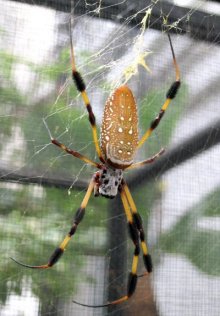By Hamish Johnston
If you hate spiders, look away now. But you will miss out on some exciting news about the wily arachnids and their sturdy silk.

Xinwei Wang and colleagues at Iowa State University in the US have discovered that spider silk is a surprisingly good conductor of heat – outperforming materials such as copper and aluminium. Indeed, with a thermal conductivity of 416 Wm–1 K–1, it’s only beaten by a handful of materials such as silver, diamond and graphene.
That’s one of the team’s golden silk orbweaver spiders pictured on the right.
The silk’s ability to conduct heat comes as a big surprise because materials created by living organisms tend to have very low conductivities. In a paper describing the finding, Wang writes “Our discoveries will revolutionize the conventional thought on the low thermal conductivity of biological materials.” While spider and silkworm silk are often thought of as being similar, the thermal conductivity of spider silk is 1000 times greater than that made by silkworms.
The team focused on the “drag-line” silk that some spiders use to anchor their webs in place. Despite being about one-fifteenth the thickness of a human hair, this silk is extremely strong and very stretchy. This inspired the researchers to measure the conductivity of stretched silk and led to another unexpected discovery – when stretched by 20%, the conductivity increased by 20%. This is unlike most other materials, which become poorer conductors when stretched. According to Wang, this “opens a door for soft materials to be another option for thermal-conductivity tuning”.
Wang believes that spider silk is such a good conductor because its crystalline structure tends to be defect free and because the presence of “spring-shaped” structures that link proteins. Both of these make it easy for heat-carrying vibrations to move along the strands.
Thanks to the discovery, spider silk could soon be used in clothes for hot climates and for bandages that keep wounds cool.
The research is described in the journal Advanced Materials.
In other spider news, Shigeyoshi Osaki of Nara Medical University in Japan has used drag-line silk to make a set of violin strings. You can listen to the results here.



